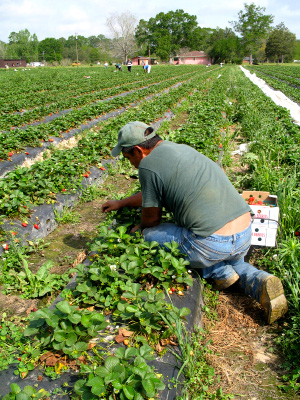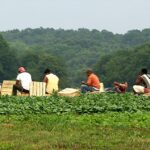BY BARRY BUSHUE | OP-ED CONTRIBUTOR
 Today, we have the best chance in over a decade to enact improvements that will strengthen border security, clarify employable status, and provide the kind of process Oregon farm families need to legally employ the capable people they depend on.
Today, we have the best chance in over a decade to enact improvements that will strengthen border security, clarify employable status, and provide the kind of process Oregon farm families need to legally employ the capable people they depend on.
BY BARRY BUSHUE | OP-ED CONTRIBUTOR
 Summer is close at hand, and thanks to farm families and their employees, we can soon enjoy the bounty of fresh, local items Oregonians cherish: succulent strawberries, marionberries, blueberries, apples and pears, and dozens of other seasonal treasures straight from the farm to your table. We’ll enjoy fine Oregon wine and the wonderful landscape plantings around our homes, businesses, and public spaces.
Summer is close at hand, and thanks to farm families and their employees, we can soon enjoy the bounty of fresh, local items Oregonians cherish: succulent strawberries, marionberries, blueberries, apples and pears, and dozens of other seasonal treasures straight from the farm to your table. We’ll enjoy fine Oregon wine and the wonderful landscape plantings around our homes, businesses, and public spaces.
Our farm families raise about 250 different types of crops, making Oregon one of the most agriculturally diverse states in the nation. Many of these specialty crops, including fruits, wine grapes, and nursery products, are delicate and labor-intensive, requiring skilled, careful hand-harvesting within a very specific timeframe to get them from the farm to you. Our state is consistently in the top 10 nationally for reliance on on-farm employees to get this important work done, and done well.
On-farm jobs are demanding, require skill and precision, and can earn employees well above the state minimum wage. But even in a tough economy, most Americans simply aren’t interested in agricultural work, whatever the pay.
As we rely on employees from other countries to do this essential work, our broken system has devolved from a set of bureaucratic hurdles into a virtual barrier. Farm families do their best to hire employees with the correct documentation, but have their hands tied by limited information and resources, and legal jeopardy in verifying employable status. The federal government has increased border security and enforcement without improving processes for employees to obtain or document their status. The federal “E-verify” system is unreliable, subjecting employers to discrimination lawsuits and legally employable people to erroneous denial of jobs with its high error rate.
Beyond the headline-grabbing documentation issues, the current H-2a program is simply not designed for the diversified family-scale agriculture we have in Oregon. Of Oregon’s 40,000 farms, only six believe H-2a can work for them.
The importance of solving this challenge is not limited to the family farm. Agriculture is Oregon’s second-largest industry. Without a legal, skilled, and reliable workforce, Oregon’s economy and quality of life suffer. And if consumers like their food grown locally, something has to change.
Congress recognized many of these issues when it developed immigration reform legislation in the early part of this century. Sen. Ron Wyden and then-Sen. Gordon Smith were among the leaders who crafted bipartisan legislation to address our system’s shortcomings. The national state of shock after 9/11 put an end to that effort’s chances.
Today, we have the best chance in over a decade to enact improvements that will strengthen border security, clarify employable status, and provide the kind of process Oregon farm families need to legally employ the capable people they depend on.
The Farm Bureau and several other agricultural groups, collaborating through the Agriculture Workforce Coalition, have outlined the elements of a labor plan to accomplish these objectives.
Farm Bureau’s agricultural labor principles include:
- Creation of a new agricultural visa program that gives employers and employees the flexibility to agree on the employment terms that work for them
- Stability via an agricultural visa that lasts at least three years and can be renewed
- A way for farm workers who are in the United States illegally to apply for legal status as they continue working in agriculture
- Enforcement and verification to ensure that agricultural visa holders are here legally and, in fact, working on farms
- A requirement that visa holders return to their home countries when their visas expire, but allows employers to continue to recruit eligible workers
- An alternative to, and elimination of, the H-2a temporary and seasonal visa program, which simply has not met agriculture’s needs
- A program that is available to all agricultural sectors, including dairy and livestock production
Most of these principles survived the rigorous bipartisan process in the U.S. Senate, which culminated in S 744, the Border Security, Economic Opportunity, and Immigration Modernization Act. This spring, the Senate Judiciary Committee passed the bill, and as this article goes to print, debate on S 744 is scheduled to begin on the Senate floor.
Oregon Farm Bureau has worked with Oregon’s congressional delegation to discuss the need for a new visa program, as well as what key components it must include, to ensure it is viable, workable, sustainable, and affordable. With the thorough groundwork done by the Ag Workforce Coalition and the serious engagement of U.S. Senators from both parties, Farm Bureau is optimistic that we can achieve a reasonable, practical, common-sense solution that works for growers, respects employees, and meets the needs of both.
The need is immediate. The opportunity is here. The time is now.
Barry Bushue is president of the Oregon Farm Bureau. He runs a family nursery stock and berry operation near Boring, Oregon.
Editor’s note: Oregon Business accepts op-ed columns on topics relevant to the state’s business community. See op-ed submission guidelines here.



